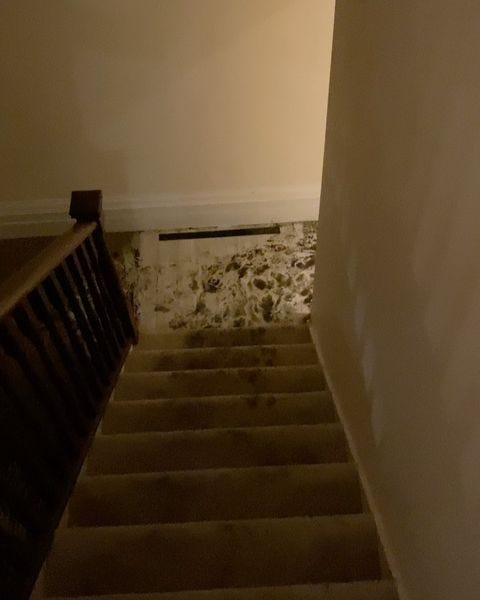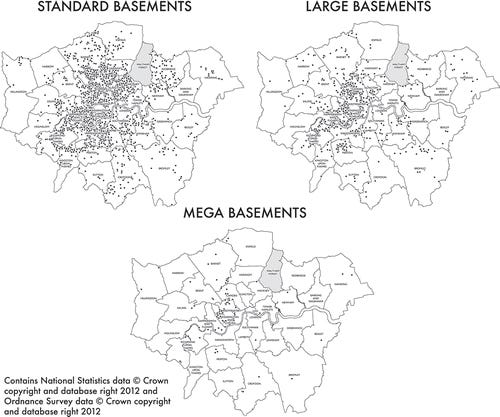The only way is up... Unless you can afford a basement conversion
Plus Crossrail's skeletons and bikestormz
Today’s the day we finally get to write about Brian May.
Honestly, the only reason we started this newsletter was to bang on about Mr Anita Dobson, but the Queen guitarist and badger fragrance magnate just hasn’t been as involved in London’s political and cultural life as we’d hoped… until now.
“Brian May blames millionaire basement extensions for flood that ‘devastated’ his home” ran the headline in last week’s Telegraph. This was basically one of those news stories that just takes something from social media and stretches it out to 700 words, so to save time here’s Brian’s Instagram post (we know you probably follow him anyway, but just in case):
Essentially Brian was complaining that flooding in his basement was caused by other people’s basements. But before you make the same mistake Boris Johnson’s sister did1, you should know that Brian’s basement is just a ‘lower ground floor’, while the kind of basements he’s blaming for the floods are ‘super’ or ‘iceberg’ basements.
If you’re not up on your basement culture war terminology, then let us help you out…
Super Basement: An origin story
The term ‘iceberg house’ started being used in the press around ten years ago to describe the ‘super-prime real estate’ of the likes of Roman Abramovich who, in their quest for space, were discovering that the laws around subterranean extensions were significantly more relaxed than those governing skyward development.
And so ‘super basements’ were born. In 2018 it was reported that 4,650 London basements had been granted planning permission in under ten years, with “almost 1,000 gyms, 376 pools, 456 cinemas, 381 wine stores and cellars and 115 staff rooms, including bedrooms for nannies and au pairs,” planned for the underground extensions.
As more and more super basements were dug out, the controversy and anger around them grew (and we’re not just talking about the five-year row between Robbie Williams and Jimmy Page). As far back as 2014, one Mr Brian Harold May of the borough of Kensington was attacking his “selfish neighbours” via his blog, accusing them of “turning Kensington into a ‘hellhole’ with their constant building works.” (scroll up that page for a lovely pic of Anita Dobson holding a cake).
As well as the noise issues, there were also rumours of ‘entombed JCBs’ being left underneath oligarch’s houses, as it was too tricky and expensive to lift them out of the massive holes they’d dug for themselves (yes, there’s definitely a metaphor in there somewhere).
But none of this stopped the trend for mega basement conversions, and the media seemed to get in on it, running articles like How to pull off a stunning three-storey basement extension, drooling over Gordon Ramsay’s £7m renovation, or reporting on the “350-room iceberg hotel with world’s deepest basement” which opened in Leicester Square earlier this month.
And there wasn’t much talk of flooding. Even in articles like this one in the Guardian highlighting how many basement extension projects were unsafe, it was more about “the risk of workers falling from height... into unguarded excavations or through unprotected floor openings” than the issue of how groundwater moves through London’s soil. Maybe substratum just wasn’t sexy enough.
But one surefire way to get an issue into the headlines is attach it to a story of wealthy, famous people being slightly inconvenienced…
A perfect storm
Last week’s flash floods in London were concentrated over the west of the city, which also happens to be the area with the highest concentration of ‘large and mega’ basements. You can guess what happened next…
Kate Garraway reveals part of her London home has been flooded after torrential rain - Daily Mail
Simon Cowell says his £15m mansion ‘nearly floated away’ - as experts blame super-basements, ancient drains and THREE INCHES of rain in 90 minutes for 'biblical' flooding in Kensington and Chiswick. - Daily Mail (again)
Rachel Johnson apologises to Brian May for ‘unkind’ post in row over mega-basements after she said it was 'amusing' that he complained about flooding in his £7m London mansion - Yeah, you guessed it, Daily Mail
Of course, people who aren’t famous also had their property destroyed by the floods, but the Mail wasn’t really interested in them. Neither were they interested in the brand new basement analysis by researchers at Newcastle University’s School of Architecture, Planning & Landscape. More fool them!
Going deep on super basements
Bunkering down? The geography of elite residential basement development in London comes at just the right time for fans of Brian May (or people interested in the future of London’s substratum) as it maps all 7,328 basements approved by the 32 boroughs and the City of London between 2008 and 2019. So if you want to see how many mega basements there are in your neighbourhood, just click below:
As well as coining the amazing term “luxified troglodytism” (great album title Brian, if you’re reading this) the report also comes up with some pretty incredible numbers:
“In total, just over 1.782 million cubic meters of earth have been removed from under Greater London to construct these basements since 2008, and then deposited elsewhere.” (that’s the same volume as 12 St Paul’s Cathedrals).
“Basements totalling a depth of 25,461 meters – that is 15.82 miles – have been excavated under London since 2008” (that’s 31 Burj Khalifas).
“163 of the privatized, individualized, super-luxury basements… have been built – often at a huge cost – within just 1000 meters of the fateful site of Grenfell Tower where 72 people lost their lives in a horrendous fire on the 14 June 2017… The costs of just one or two of even the most modest of these excavations would have been more than enough to pay for adequate cladding of a type that would have prevented the fire and all that has followed from it.”
Now, Mr Cowell, tell us again about the pain of your flooded basement.
One of the key parts of the report is “basements are being built as part of a far broader process of asset accumulation and investment, which is particularly potent amongst the very wealthiest, but which is now having a much more general impact.” Or, in other words, you don’t have to be Roman Abramovich to get a basement extension these days. In fact it might be easier to do than a loft extension.
Because of this increasing popularity, the report suggest that equal scrutiny needs to be given to the “dramatic construction booms surrounding the luxury basement belt” as has been given to the “forests of super-tall, luxury housing towers,” especially considering the huge “volume of soil excavated by the wealthy in London to create their luxurious bunkers since 2008”.
In the end the report calls for more research into,
“the increasing power of the super-rich to dramatically and rapidly reshape the landscapes and geographies of global cities.”
If only we knew someone rich enough and angry enough to take on that mission… 🤔
Meanwhile, in the sky
Back in April we took a brief look at London’s ‘tall building news’, so we thought we’d do a quick update now, if only for the sake of synchronicity.
Over at the Building Design site, the ironically-named architect Ben Flatman has had a bit of a ‘Network’ moment, calling London’s skyline “a mess” and asking “Should architects feel ashamed?”.
Flatman argues that “once uncluttered skies are now interrupted… quiet streets are increasingly overshadowed and overlooked,” and “familiar London streetscapes have begun to blur into Dallas or Dubai when your gaze rises above the roofline,” creating what he calls “a discordant mess”.
In his last few sentences Flatman seems to echo the researchers of Newcastle University’s School of Architecture, when he asks,
“Why do so many British architects seem to have been reduced to acting as the servile agents of capitalism, regardless of its impact on the city they all claim to cherish?”
Meanwhile, the Grenfell Inquiry has entered its 43rd week and the depressing and infuriating revelations are still coming.
Just this week it emerged that a “leak in one of the gas risers supplying flats in the tower” was never properly repaired and this could have contributed to “the spread of smoke through the lobbies on the night of the fire”. Also, a £600,000 lift upgrade hadn’t included “modernising the lift to meet firefighting lift requirements.”
It was also reported this week that more than 900 buildings in London are on ‘simultaneous evacuation orders’ due to fire risk. That is, there’s 900 buildings that “currently require safety measures such as waking watches or common alarm systems due to fire safety defects including flammable cladding.”
This week, Housing Secretary Robert Jenrick is expected to announce details of a ‘polluter pays’ tax on new high-rise developments “to fund the repair of fire safety defects – including unsafe cladding – on existing buildings.” Although cladding campaigners have been using that #PolluterPays hashtag for a long time now and they’re not happy about Jenrick stealing it.


Meanwhile the government’s plan to help people in high-rise homes to sue developers over the cost of fixing fire safety defects came in for a bit of a kicking, with the main criticism being that many home owners don’t have the kind of money needed for litigation (and even if they did, a lot of the developers from over a decade ago just don’t exist anymore).
And the rest
One last property-related story: The mayor is planning up to 46,350 new homes on land owned by TfL, and is “now in talks with ministers over a £2.1bn taxpayer grant to finance the housebuilding project”.
More bad news for Cressida Dick this week when leaked documents revealed “cases of violent disorder, cheating and dishonesty” at the Met’s main training centre in Hendon. The documents also reveal that during an internal question-and-answer session last year, Dick was “forced to deny rumours that an entire intake of Hendon recruits had failed the initial selection process but were still given a start date because ‘the Met needed the numbers’.”
The FA announced this week that they’ll be launching an independent investigation into the “disgraceful scenes” at the Euro 2020 final at Wembley, in order to discover just “how fans without tickets were able to force their way into the stadium.” Apparently “there have also been allegations of corruption involving match-day staff.”
Our favourite civil engineering periodical New Civil Engineer reports on the challenges of building Crossrail’s Liverpool Street station, including navigating “a maze of sewers, existing Tube lines and the Post Office Railway” and the discovery of “nearly 4,000 skeletons from the Bedlam burial site and thousands of artefacts dating back to Roman times.”
A few issues ago we told you about Bikestormz, now GQ have published a whole feature on how the #BikeLife movement has reclaimed London’s streets for its youth.
If you’re watching the Tokyo Olympics on the telly later this week then you might hear yourself, as the organisers are using “crowd noise from London 2012 to create an atmosphere for athletes inside the fan-free stadiums”.
Yes, that is the first and likely only time we will link to an article from Metalhead Zone.





